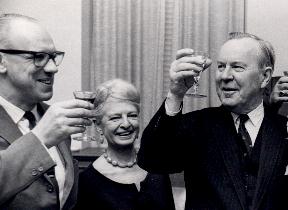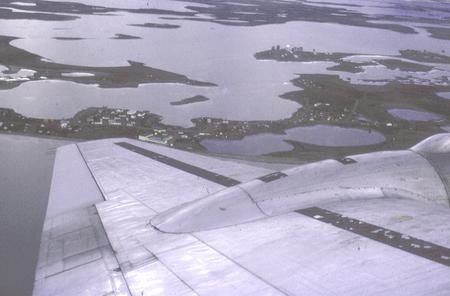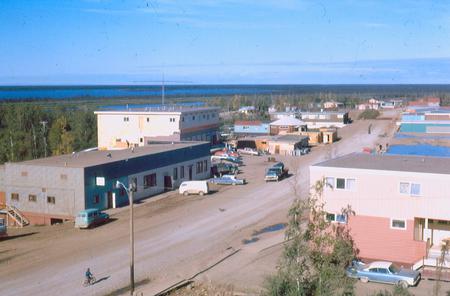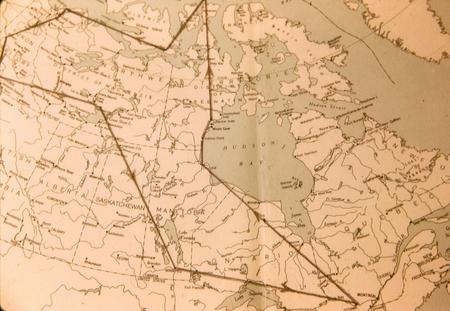Memoirs of a Boffin
Chapter 9. The Ottawa Scene (1965-1971)
The Ottawa scene was fairly familiar to me through my work with the Defence Research Board and, later, with the Glassco Commission. Working with Cabinet Committees was also familiar, through serving the War Cabinet Sub-Committee on IFF and Radar Beacons in Britain during the war. The offices of the Cabinet were not unlike their counterparts I had known in the UK. It would no longer be true today. There were many changes in the 70s and 80s, not many for the better.
The PCO (Privy Council Office) and the PMO (Prime Minister’s Office) were small, effective bodies at that time (September 1965). They were recognizably separate at an official level but were friendly at a social level. Indeed, the whole environment in the old East Block of the Parliament buildings, which housed the PMO and PCO, was a very friendly one, making it very easy to adapt to. The family feeling was encouraged by Prime Minister Pearson who gave parties for the staff at Christmas and on his birthday.
Everyone, down to the most junior secretary was invited. This was before the bureaucratic population explosion of the ’70s, so the entire party fitted easily into Lester Pearson’s private office. Sherry was served with a Christmas or Birthday cake, as appropriate, provided by Mrs. Pearson, who was always present.
There was a good deal of friendly banter at these parties, because some of the staff had spent many years together. The PM took these opportunities to present gold watches to staff who had 25 years’ service. On one occasion, one of the recipients was the Master of Protocol, who was a close friend of the Pearsons. He was near the end of the award list. When his name was eventually called, he huddled with the PM and spent quite a long time speaking in whispers that were inaudible to the rest of us. Conscious that the audience was restless, Pearson came out of the huddle saying, on the spur of the moment: “Sorry about that; as Head of Protocol he was just telling me that I got it all wrong – he should have been first”. A typical example of Lester Pearson’s spontaneous, disarming wit.
At that time (1965) the Prime Minister’s office was above the central portico of the East Block overlooking the East lawn. Mine was on the ground floor just to the right of the portico. The mornings were enlivened by the Changing of the Guard ceremony which took place on the East lawn every morning in summer.
In the early Trudeau years, the number of people in the PMO and the PCO grew out of all proportion and intimate parties of this kind were no longer possible. I remember an attempt at a PMO/PCO Christmas party in Pierre Trudeau’s first year as Prime Minister. It was held in the Ballroom of an Ottawa Hotel and, to those of us who had experienced Pearson’s intimate gatherings it was a dismal failure.
The creation of a Science Secretariat in the Privy Council Office was quite an innovation and it was up to us to establish its role. One of the first jobs I had as Deputy Director was to write the “instructions” to the Department of Justice for a Bill to create the Science Council of Canada. The “instructions” are a statement in plain English of what you want the Act to achieve. The Department of Justice then translates them into the watertight legal language of the Bill.
There has been, and still is a great deal of misunderstanding about the relative roles that we intended for the Science Secretariat and the Science Council when we wrote the Glassco Report. The Science Secretariat was to be a very small internal advisory body, with three main functions. The first was to advise Cabinet on any matters relating to or involving science and technology that were put before it by the regular Departments and Agencies. This was to be done not as a critique of the proposals of others, but by making sure that Cabinet was well enough informed on the broad issues involved to see its decisions in a wider perspective than that provided by the Department submitting the proposal, which was, after all, a potential beneficiary of the Cabinet decision. The second function of the Science Secretariat was to place before Cabinet proposals in new areas of science and technology not already covered by existing Departments and Agencies , as well as proposals relating to a national science policy. Prime examples of the kind of initiatives that were introduced and managed by the Secretariat were the creation of the Science Council of Canada and the introduction of a Canadian Communication Satellite Program which involved the establishment of Telesat Canada and the Department of Communications. The third function of the Science Secretariat was to provide support for the secretariat of the statutory Cabinet Committee on Scientific and Industrial Research, which had been established years before by what was colloquially known at that time as the National Research Council Act, because it also established the legal status of NRC.
So the entire work of the Science Secretariat was internal and confidential to Cabinet like the Cabinet Briefing Room. The Science Council, on the other hand, was created as a public body, funded by Government but at arm’s length to it. The Science Council was to be a committee of individuals, external to government, who had distinguished themselves in academic, industrial, or other work related to science. It was to provide independent comment on government science policies by publishing its views in Science Council Reports. In order to develop these views, it could commission reports to the Council by experts, on the basis of which it would develop its own reports, which were approved by the Council before publication. In this way the Government could see two consecutive reports and the public and scientific reaction to them, before perfecting its own policy on that subject. In theory! In practice, for a variety of reasons, the timeliness and relevance of Science Council activities was only maintained in the early years, under the Chairmanship of Dr. O.M. Solandt and was virtually lost for the rest of the Council’s life.
Nevertheless it would not have been difficult, with the right leadership and hands-off government support to reinstate the effectiveness of the early days of the Council. However, the Science Council was abolished by the Mulroney government in 1992, along with the Economic Council and other advisory bodies, in one of the many short-sighted, irresponsible moves which characterized that government.
One of the problems of the Science Council has often been the ambition of successive Chairmen to be involved in the internal advice to and operations of Cabinet. To me, that is a direct conflict of interest and removes any argument there might be for an independent, objective Science Council. Another, more serious problem arose with the creation of the Ministry of State for Science and Technology which, has confused the whole issue of the role of science and technology in government to this day.
The Science Council Act passed into law in 1966. The first meeting of the Council, under the Chairmanship of Omond Solandt, was held in the Confederation Room of the West Block of the Parliament Buildings and was opened by Lester Pearson. At this time the Science Council Act did not provide for the employment of staff directly and I was asked to provide support for the Science Council within the Science Secretariat. From the outset both the Chairman, Omond Solandt and I recognized this as a deficiency in the Act and we set out to remedy it. The amendment took effect on November 1st, 1968. As soon as the Act was amended, the staff that had been hired was transferred to the Council. Ray Jackson, who had been with me in RCA Victor, was one of them. The Secretary of the Council, Jim Mullin, formerly of Atomic Energy of Canada Ltd., was another. Before this was done we had already established the well-known red and green reports – red for the Council’s own reports and green for consultants’ reports (“special studies”) to the Council. By this time, four Council reports had been issued and eight special study reports had been issued or were close to completion. The first four major topics were the Space Program, the proposal for an Intense Neutron Generator, Water Resources Research and a National Science Policy.
Another old friend from Glassco Commission days, Bob Weir had joined the Science Secretariat on my recommendation. Indeed, it was ironic in the light of later events that, after suggesting his name, I was deputed to call him and offer him the job. So our association, which had been started during the Glassco Commission, was destined to continue. We always worked agreeably together – perhaps because our modus operandi, our disciplines and our personalities were quite different and, in a true sense complementary.
Omond Solandt was not only the first but, I believe the best of the Chairmen of the Science Council over the years until its sad demise in 1992. For years he had been Chairman of the Defence Research Board and a Chief of Staff so he knew the ropes inside government, as well as outside. Moreover he was known and respected by Senior Deputy Ministers of the time, particularly those of Treasury Board and the Department of Finance. He alone was able to balance the public role of the Science Council in spite of his own, inevitable personal involvement in giving confidential advice to ministers, outside his Science Council mandate. He was authoritative, direct and fair and was a pleasure to work with. The first three or four Annual Reports of the Science Council (1966-70) give a good indication of his insight into the nature of the Science Council role.
My friendship with Omond Solandt was happily renewed in the late 1980s when we were both on a panel setting the rules for research tax credits. We were able to spend a good deal of time together comparing notes and I was delighted that his interpretation of some of the events of those intervening years, particularly the demise of the RCA Victor Research Laboratories, coincided with my own. His death in 1993 came as a blow.
An early job in the Science Secretariat took me to Barbados to see Gerry Bull’s remarkable High Altitude Research Project (HARP). Gerry was a brilliant engineer who had spent most of his career up to then in government research at the Canadian Armaments Research and Development Establishment at Valcartier, Québec. He had left because they would not pursue this project and had joined McGill University. His idea was to use a large gun to project instrument packages into the upper atmosphere, to make measurements. He was sure that, ultimately, he could put a small satellite in orbit, using the gun.
To these ends he had designed an enormous gun – a launch tube, really, consisting of two old 15” naval guns welded precisely end to end. This inclinable 120’ launching device was an impressive engineering achievement, especially as the construction was carried out largely by Gerry himself and his engineering students. I attended a week of trials of the gun. During each firing we hid in little concrete bunkers, in case the gun exploded. It never did and its performance was always close to that predicted by Gerry. It seems a pity that support was withdrawn before he realized his ambition of putting a package in orbit, which he certainly would have done, given the means.
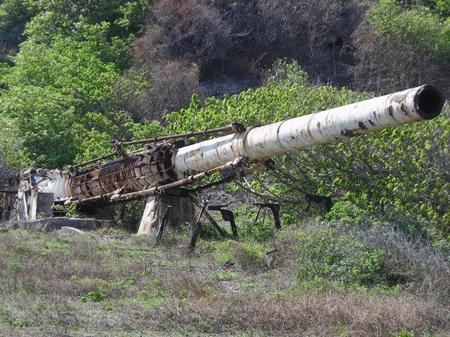
The remains of the abandoned
(Photo released to public domain by user 'Brohav' of en.wikipedia.org)
I took some time off on the Saturday afternoon in Barbados to tour in his car with one of the Ministers of Errol Barrow’s Government around several league cricket matches being played in various parts of the island. At one stop I started to wind up the window with a view to locking the car to protect my two cameras, left on the back seat. “Don’t do that,” he said, “it will get hot”. “But what about the cameras?” I asked. “No-one will touch them,” he said. And they never did! I think the advent of American tourism in the ’70s changed all that.
One afternoon I was invited to a Garden Party by the Prime Minister, Errol Barrow. As the guests were leaving, I felt a hand on my shoulder and Errol Barrow said quietly, “Don’t go just yet”. I stayed behind and found that I had been invited to stay for dinner with the Barrows. The other guests were all the members of his Cabinet, but there was no other ‘outsider’. Practically everyone around the table (except the Prime Minister, who could more than hold his own in any company) had a degree from Oxford, Cambridge or Harvard and the conversation was disciplined, articulate and substantive, in a style that was quite familiar to me from meals at High Table in Gonville and Caius College. It was a fascinating contrast to the Canadian Cabinet.
I learned from the Prime minister, Errol Barrow,that he had a very high opinion of Gerry Bull. They were good friends and he also must have been very disappointed when the funding for the HARP project was cut off so abruptly.
Gerry was an intensely patriotic Canadian. The series of setbacks that his work suffered at the hands of the Canadian Government hit him very hard. He was disgusted (as so many of us were, and still are) with the attitude of successive governments towards scientific research and innovative ventures, or indeed to excellence in any type of endeavour. I think his disillusionment started with the cancellation of the Arrow aircraft (in which he had no vested interest) and was consolidated when his own establishment, CARDE rejected his ideas. This latest withdrawal of support was the last straw: he would go it alone. He built a firing range on family property spanning the Canada-U.S. border and got into the weapons business. He got into trouble over dealings with South Africa and served a spell in a US prison.

A rare shot (from an 8mm movie frame) of Gerry Bull at work during the trials
Following his release from prison, Gerry Bull surfaced in the armaments business in Europe and hit the headlines for a last time when he was assassinated by a bullet from a silenced gun as he was about to enter his apartment in Brussels in March, 1990. My feeling has always been that the Canadian Government should have been flexible and wise enough to retain the loyalty of someone as energetic, talented and capable as Gerry Bull. It is little consolation that international experts now refer to him as perhaps the greatest artillery expert of all time. Gerry was wrong to allow his enthusiasm for his creations to force him into accepting money from the wrong hands. But I can understand how it happened, even though it is difficult to condone.
During the Gulf War, Saddam Hussein must have reflected with some satisfaction that Canada’s persistent rejection of Gerry’s engineering genius had resulted in a situation where the finest artillery in the world was in Iraqi hands, not those of the coalition forces.
The Privy Council Office also gave me the opportunity to tour the North. “Bud” Drury was Chairman of the Science Committee of Cabinet and he invited me to join his annual tour of the Arctic, which was organized for foreign diplomats and the press. We flew in a DC7 from Ottawa to Churchill Manitoba where we visited the Churchill Rocket Range whose future was being questioned at the time; then on to Resolute Bay on Cornwallis Island. We picked up two Inuit stewardesses at Churchill. As they boarded the plane the Japanese Ambassador, who was sitting next to me remarked, in surprised tone “Oh, you have Japanese Flight Attendants”. I told him they were Inuit but he was certain they came from Hokkaido – he would recognize their features anywhere. He was astounded when they were introduced to him and found it hard to believe that they did not speak or understand Japanese. We stayed overnight in Resolute. My recollection of it is something like my image of the surface of the moon – mainly crushed rock of various sizes. Cambridge Bay, our next stop, was more interesting and we were able to see something of the way people lived.
We then went on to Tuktoyaktuk and Inuvik, where we stayed in the School buildings for the night. Among the press on that flight there was the familiar face of the well-known journalist Blair Frazer. Some of the party went fishing early the next morning and I recall Blair Frazer and one or two others cooking delicious fresh Arctic Char for a sumptuous breakfast for the whole party.
We attended a civic meeting in Inuvik, where I met the owners of the (then) only private hotel north of the Arctic circle. They were of German origin and had apparently owned an hotel in Edmonton, before going to Inuvik. I asked the wife “Don’t you find it very cold, living in Inuvik?” She answered “What – after Edmonton? Then she explained that, in the extreme cold, you don’t go out much in either place. But Edmonton is much windier than Inuvik, so it always seems colder when you do go out.
While our aircraft flew on to Whitehorse, we took a DC3 to Dawson City and spent a few hours exploring that ghost town of the Gold Rush era. The whole city is a museum – or so it seemed. Rather a sad experience on the whole.
We returned to Ottawa via Whitehorse, Yellowknife and Winnipeg after a flight of about 8500 miles. While nothing concrete was achieved on the trip, the experience completely changed our attitude to the North. There is no substitute for being there.
One day (probably in 1967) a young messenger came to me with a message from Mr. Pearson. It consisted of a letter he had received from some scientific dignitary who had visited France and sought help from the Canadian Embassy in Paris in arranging visits to French research establishments. The letter was to the effect that no-one in the Embassy knew anything about science, Canadian, French or otherwise. He thought this was scandalous.
Pearson had scribbled at the bottom of the
letter “Is there anything in this?”. The boy was waiting for the
reply, so I added to his scribble: “Yes there is – we should do something
about it.” Within a few minutes the messenger returned. The PM in turn had
added: “Why don’t you do a paper to Cabinet and let me see it first.”
The result was that within three weeks we had authority to place Science
Counsellors in several main embassies abroad. The Department of External
Affairs agreed to house and feed the Counsellors, as Embassy staff, but they
would be selected by us (the Science Secretariat) and route their substantive
reporting to us. This very practical arrangement worked well for several years
until mutual confidence was disrupted by the creation of the Ministry of State
for Science and Technology (MOSST). I believe Science
Counsellor is now a regular diplomatic appointment which may or may not have very
much to do with science. Furthermore, I believe one of the first acts of the
Kim Campbell government on taking office in 1993 was to abolish the Science Division
of the Department of External Affairs.
Plus ça change...
It was early in the Science Secretariat days that I had the opportunity to polish up my French. I had eight years of French, including some study of French literature at grammar school and I had chosen French as the modern language that was a mandatory ancillary to the university physics course. Unfortunately, the language had been taught to us much more as a written than as a spoken language. Although I could still read it easily in the 1960s, I could not converse in it with any fluency.
So, I enrolled in one of the first “total immersion” courses provided by the Canadian government – no doubt quite different from those given today. It was quite an experience.
There were ten senior executives enrolled in the group I was in. We were sent to the Hotel de l’Éstérel in the Laurentians for an initial period of three weeks. We were introduced to a course supervisor and three professors. There were also six “monitrices” whose job was to provide informal conversation outside the classroom and help the professors to ensure that none of us ever spoke anything but French during the whole three weeks.
As a result we got to know our anglophone colleagues’ personalities only through their behaviour when they spoke French. I found later that this did not always reflect their normal personalities – especially if they had a hang-up about French, as many anglophone Canadians seemed to have.
I knew a great deal more French grammar and vocabulary than any of the others, so I was able to hold long conversations as early as the first week, while some of the others were still very confused. Their confusion was accentuated by the policy to teach the spoken language only by practice and to allow no explanation or translation to or from English. While this technique no doubt works for a 3-year old, it clearly does not work for an intelligent adult, who wants to know the grammatical basis for what he is saying and needs to visualize the words. There was a great deal of frustration for those who did not already know the written language.
The penalty for speaking one English word during the course was a nickel, which was dropped into a champagne magnum provided for the purpose. One evening a well-known General who was on our course was being pressed by a couple of monitrices to keep up a rapid-fire conversation in elementary French. He could not find the words. He became increasingly frustrated, until he was practically apoplectic. Finally he fished a dollar bill out of his pocket, stuffed it into the neck of the magnum and shouted “God damn and blast this bloody course”.
One of the pleasures of l’Éstérel was the food and the wine. The Sommelier, a Belgian called Jules-François, was a delightful character and an expert on wines. He gave us a seminar one day on French wines. At the end of it, one of the students asked him how he had managed to talk for an hour and a half about wine without once mentioning white wines. Jules-François replied that he was talking for the discriminating palate, which only red wines will satisfy. “As for white wines, if you’re thirsty,” he said “you can swig a bottle or so before dinner without doing much harm – it just goes in one end and out at the other.” In fact he was equally expert on the better whites but, above all, he was a performer and liked to exaggerate for effect.
One day, in the restaurant a couple of ‘students’ at another table ordered Calgary red-eyes – a heathen combination of liquor and tomato juice. Jules-François caught a glimpse of these as he passed their table. He picked one up, held it to the light and commented, with mock seriousness, “Un peu trop sédimenté!”
At the end of the three weeks we were allowed to hold a postmortem in English, with the course director. It was a revelation to see the true character of certain members of the group emerge. One man in particular had been almost sick with anxiety throughout the stay. He had given the impression in French of being a timid, nervous man who was, perhaps not very bright. Much to our surprise, he took the lead in this postmortem. His criticisms of the course were similar to mine but much better (indeed brilliantly) articulated. But he must have had a huge, subconscious chip on his shoulder about learning French. Nevertheless, consciously, he swore that he wanted to learn it. Certainly the teaching methodology was appallingly bad for intelligent adults. I think some of the professors knew its weaknesses, but they had it forced upon them by the education bureaucracy.
I had an aggregate of thirteen weeks in total immersion within about a year – a further three weeks at l’Éstérel and a total of seven weeks in Quebec City. During two or three of those weeks, I lived with a gracious Quebec family as part of the course. The date can be anchored accurately because I watched the French TV news with them during the events surrounding the assassination of Pierre Laporte.
I also attended a Parti Québecois rally at the Coliseé and experienced the enormous enthusiasm of the crowd, whipped up by René Levesque and the songs of Gilles Vigneau. We had learned “Mon Pays” and other songs during our course, so were able to join in like good Québecois.
The total immersion experience was a pretty useless one for the great majority of senior officers, few of whom had a practical command of French at the end of it. It was useful to me only because of my previous grounding in the language at school. Nevertheless, the maintenance of spontaneous fluency depends on the sustained use of the language which, in Ottawa was impossible at the time. I discount the halting, excruciating exchanges in French between anglophones who are equally incompetent in the language. That is the most useless, harmful, and degrading exercise of all. You don’t learn tennis by playing a beginner. However, the courses enabled me to enjoy my frequent visits to Brussels and Paris and represent Canada there in a way that would not have been possible without them. Moreover, the stay in Québec gave me a much better insight into the problems of bilingualism in Canada but did not decrease my criticisms of the bilingualism policy.
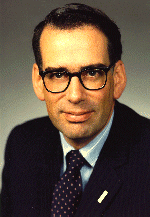
Michael Pitfield
My principal contact in the Privy Council Office (PCO) outside our Secretariat was Michael Pitfield – a close friend and confidant of Prime Minister Trudeau. Michael was the main link between the PCO and the PMO. He was very young at the time but had a natural air of authority derived from private schooling that some of us never acquire. He was generally supportive of what we were trying to do and his manner was always friendly and helpful. Through Michael I also had frequent contact with the head of the PMO, Marc Lalonde, who later stood for parliament and became a Minister for a time in the Trudeau government. It was because of these two men that I was able to work effectively to bring about some major changes in spite of impending personnel changes in the Science Secretariat itself and, in my view, the consequent decline of its influence, ending a few years later in its transfer to an ineffectual Ministry of State for Science and Technology.
